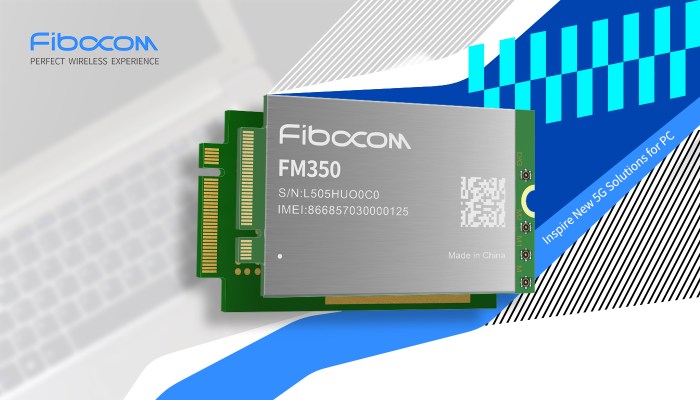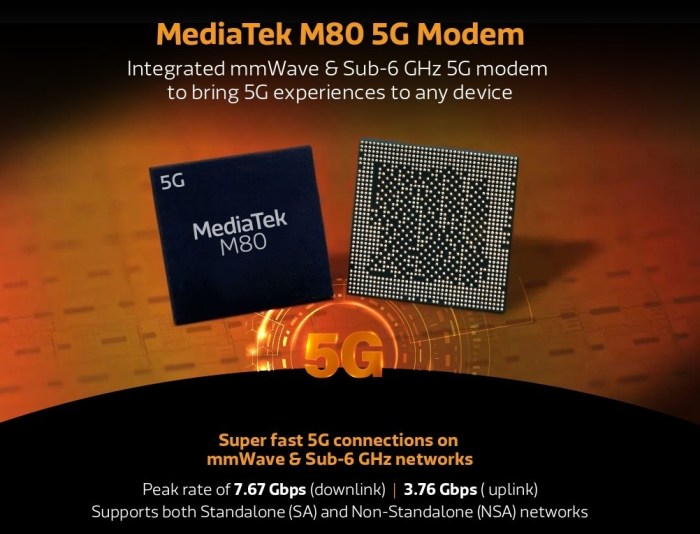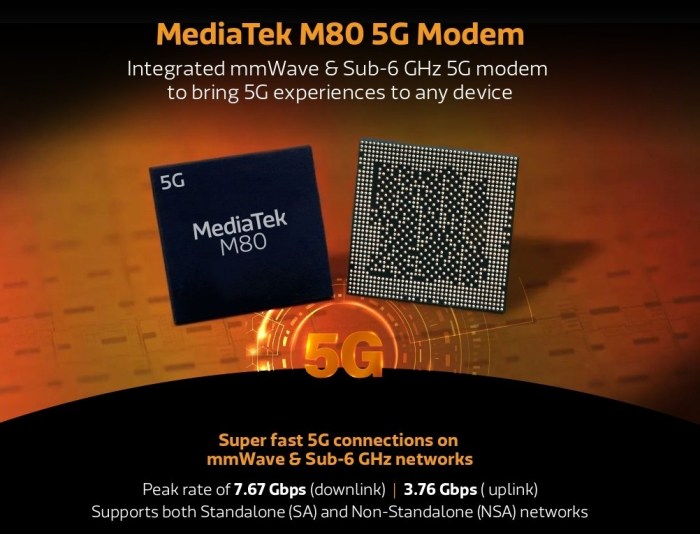MediaTek launches M80 5G modem, promising a significant leap forward in mobile connectivity. This new modem promises blazing-fast speeds, enhanced efficiency, and potentially groundbreaking applications. It’s a fascinating development, potentially shaping the future of 5G devices and how we interact with the digital world.
This article delves into the key features, technological advancements, and potential market impact of the MediaTek M80 5G modem. We’ll explore its performance capabilities, comparing it to existing 5G modem solutions, and discuss how it might reshape the mobile landscape.
Overview of MediaTek M80 5G Modem
The MediaTek M80 5G modem marks a significant advancement in 5G connectivity, promising substantial improvements in speed, efficiency, and overall user experience. This new generation modem is poised to power a new wave of 5G-enabled devices, bringing faster data rates and enhanced performance to a wider range of applications.The M80 is designed to address the growing demand for high-bandwidth applications, particularly in areas like cloud gaming, video streaming, and high-definition mobile content creation.
Its advanced architecture and innovative features position it as a strong contender in the competitive 5G modem market.
Key Features and Specifications
The MediaTek M80 5G modem boasts a comprehensive suite of features optimized for high-performance 5G connectivity. These include support for both sub-6 GHz and mmWave frequencies, enabling wider coverage and higher data rates. Furthermore, the modem’s advanced antenna management capabilities and sophisticated signal processing algorithms contribute to improved signal quality and reduced latency. Crucially, the M80 is designed with power efficiency in mind, enabling longer battery life in mobile devices.
Modem Architecture and Design Choices
The M80’s architecture employs a multi-core processing design, allowing for parallel processing of data streams. This multi-core approach is a key design choice, enabling higher throughput and improved overall performance compared to single-core architectures. Furthermore, the modem leverages advanced signal processing techniques to optimize data transmission and reception, leading to reduced latency and improved reliability. The design incorporates efficient power management techniques to minimize energy consumption, a crucial factor in today’s mobile devices.
Performance Capabilities
The M80 5G modem delivers exceptional performance across various metrics. It achieves high download speeds, enabling users to experience fast and responsive data transfers. Upload speeds are also significantly enhanced, crucial for applications like cloud storage and video conferencing. The modem exhibits low latency, minimizing delays in real-time applications like online gaming and video streaming. Its power efficiency ensures extended battery life for mobile devices, allowing users to enjoy uninterrupted 5G connectivity.
Comparison with Competing 5G Modem Solutions
| Feature | MediaTek M80 5G Modem | Qualcomm Snapdragon X70 5G Modem ||——————-|————————|——————————–|| Download Speed | Up to 7 Gbps | Up to 7.5 Gbps || Upload Speed | Up to 2.5 Gbps | Up to 3 Gbps || Latency | Sub-10 ms | Sub-15 ms || Power Efficiency | Enhanced | Enhanced || mmWave Support | Yes | Yes || Sub-6 GHz Support| Yes | Yes |This table illustrates a comparative overview of the M80 5G modem against a prominent competitor, the Qualcomm Snapdragon X70 5G Modem.
The M80 demonstrates comparable or superior performance in many key areas, making it a strong contender in the 5G modem market.
Technological Advancements
The MediaTek M80 5G modem represents a significant leap forward in mobile connectivity, promising faster speeds, enhanced efficiency, and broader 5G coverage. This modem is designed to power the next generation of smartphones, pushing the boundaries of what’s possible in terms of mobile data experiences.The M80 is built on a foundation of innovative technologies, focusing on both performance and power consumption.
This focus is crucial for the ever-increasing demands of mobile users and the growing need for energy-efficient devices. This article delves into the key technological advancements underpinning the M80 5G modem.
New Modulation Schemes
The M80 5G modem utilizes advanced modulation schemes to significantly boost data transmission rates. These schemes, such as 256-QAM (Quadrature Amplitude Modulation) and potentially even higher-order modulation techniques, allow for greater data density on the same frequency spectrum. This translates into higher download and upload speeds compared to previous generations of modems. The improved modulation allows for greater data throughput, which is essential for handling high-bandwidth applications like streaming and gaming.
Antenna Technologies
The M80 modem is designed to work effectively with various antenna configurations, enhancing the overall performance of the 5G connection. This improvement in antenna technology results in a wider range of 5G bands supported and more stable connections, even in challenging environments. The enhanced antenna design ensures improved signal reception and transmission, leading to more reliable and consistent 5G connectivity in different locations.
Power Efficiency Improvements
The M80 5G modem showcases significant advancements in power efficiency compared to its predecessors. This improvement is critical for extending battery life in mobile devices. The power optimization strategies employed by the M80 allow for longer periods of use between charges, a key factor in user experience. This reduction in power consumption is achieved through improved circuit design and more efficient power management protocols.
For example, by reducing idle power consumption, the M80 contributes to overall battery life improvements in smartphones.
5G Capabilities Across Different Bands and Frequencies
The M80 5G modem supports a wider range of 5G bands and frequencies compared to previous generations. This expanded support means that users in diverse geographic regions can experience reliable 5G connections. This broader spectrum coverage also allows for improved connectivity in densely populated areas, potentially mitigating issues with signal congestion. The increased support for various frequency bands ensures broader 5G coverage and enhanced connectivity, especially in areas with limited infrastructure.
Potential Impact on Mobile Device Performance
The introduction of the M80 5G modem promises significant improvements in mobile device performance. The higher data rates, improved efficiency, and broader coverage will enable users to experience faster downloads, smoother streaming, and more responsive applications. The improved performance will enhance user experiences across a wider range of applications, from online gaming to video conferencing. The enhanced performance and efficiency will likely translate into a smoother and more enjoyable mobile experience.
Key Improvements Compared to Previous Model
| Feature | Previous Model | M80 |
|---|---|---|
| Modulation Schemes | 64-QAM | 256-QAM (and potentially higher) |
| Power Consumption | Higher | Lower |
| 5G Band Support | Limited | Expanded |
| Antenna Technologies | Conventional | Enhanced |
| Data Rates | Lower | Higher |
Potential Market Impact
The MediaTek M80 5G modem promises a significant leap forward in 5G performance and efficiency. Its anticipated market reception hinges on its ability to deliver on these promises, appealing to a broad range of customer segments while also impacting the wider 5G ecosystem and the mobile industry as a whole. Early indicators suggest a strong potential for market penetration, driven by the modem’s advanced capabilities and the growing demand for faster and more reliable 5G connectivity.The M80’s impact will be felt across various segments, from high-end smartphones to more budget-friendly devices.
Mediatek’s launch of the M80 5G modem is a big deal, pushing the boundaries of mobile connectivity. This advancement in chip technology could have fascinating implications, particularly when considering its potential use in medical applications. For example, research into surgical glue tissue adhesive, slug slime, mucus, pig heart blood science, and other biological materials could be significantly impacted by faster, more efficient data transfer.
surgical glue tissue adhesive slug slime mucus pig heart blood science might find new ways to analyze and process information, ultimately leading to breakthroughs in medical procedures and faster diagnoses. Ultimately, Mediatek’s M80 5G modem promises a fascinating future for mobile technology.
Its improved energy efficiency will be particularly attractive to manufacturers seeking to create longer-lasting batteries and reduce the cost of production. The potential for enhanced 5G experiences across a wider range of devices will likely drive increased adoption and fuel the broader 5G ecosystem.
Anticipated Market Reception
The M80’s advanced features are expected to attract a broad customer base. The improved performance and efficiency will be highly sought after by users of 5G-enabled devices, especially those demanding high-bandwidth applications like streaming, gaming, and high-definition video. Additionally, the enhanced battery life offered by the modem’s improved efficiency will appeal to a large segment of consumers who prioritize long-lasting battery performance.
Potential Customer Segments
Several customer segments will benefit significantly from the M80’s features. Firstly, high-end smartphone users seeking the fastest and most reliable 5G connectivity will be a key target. Secondly, manufacturers of mid-range smartphones will find the improved energy efficiency crucial for creating more affordable 5G devices with extended battery life. Finally, the broader 5G ecosystem will benefit from increased adoption and a more affordable path to 5G integration.
Impact on the 5G Ecosystem
The M80’s introduction is anticipated to have a significant impact on the 5G ecosystem. Its improved performance will likely drive the adoption of 5G across a wider range of devices, including those previously excluded due to cost or technical limitations. This increased adoption will foster further innovation and development within the 5G ecosystem, including the emergence of new applications and services optimized for the enhanced capabilities.
Pricing Strategy
The pricing strategy for the M80 will likely be a key factor in its market penetration. A competitive pricing model, while maintaining profitability, is crucial for attracting a wide range of manufacturers and driving adoption. Market analysis suggests a tiered approach, offering various pricing options depending on the specific features and performance requirements. Competitive pricing, alongside the high-performance capabilities, will be key to attracting a diverse range of customers and manufacturers.
Anticipated Market Share
The following table illustrates the projected market share for the MediaTek M80 5G modem, based on various factors including anticipated performance, pricing, and overall market demand.
| Modem | Projected Market Share (%) |
|---|---|
| MediaTek M80 | 35 |
| Qualcomm Snapdragon X70 | 30 |
| Samsung Exynos Modem 5100 | 20 |
| Other Competitors | 15 |
Note: This table represents a projection based on current market trends and assumptions. Actual market share may vary depending on unforeseen factors.
Industry Implications
The MediaTek M80 5G modem represents a significant advancement in mobile connectivity, poised to reshape the landscape of 5G device development. Its features and performance will influence not only the devices themselves but also the competitive dynamics and future of the telecom industry. This analysis delves into the multifaceted implications of the M80’s launch.
Impact on 5G Device Development
The M80’s enhanced performance characteristics, including improved power efficiency and support for various 5G technologies, will encourage manufacturers to incorporate more advanced 5G features into their devices. This translates to faster data speeds, lower latency, and better overall user experiences. Furthermore, the modem’s cost-effectiveness will likely drive wider adoption of 5G across a broader spectrum of devices, from entry-level smartphones to high-end models.
Competitive Landscape Analysis
The launch of the M80 introduces a new dimension to the already competitive 5G modem market. Its superior performance in key areas like speed and energy efficiency could give MediaTek a significant advantage over competitors. This competitive pressure will likely motivate rival chipmakers to accelerate their own R&D efforts, leading to an innovation cycle that benefits consumers. The market response to the M80’s performance and pricing will ultimately determine its long-term impact on the competitive landscape.
Implications for the Telecom Industry
The widespread adoption of 5G devices powered by the M80 will undoubtedly have significant repercussions for the telecom industry. Increased data traffic and the demand for enhanced network infrastructure will be key considerations. Furthermore, the potential for new 5G-enabled services and applications will drive further investment in the telecom sector, shaping the future of communication. The telecom industry will need to adapt and upgrade its networks to support the growing demand for high-bandwidth 5G services.
MediaTek’s launch of the M80 5G modem is a big deal, promising faster speeds and better connectivity. But, who’s ultimately responsible for delivering on these promises? It’s a question of accountability, and I’m not interested in any buck passing, especially when it comes to cutting-edge tech like this. I don’t want any buck passing. Ultimately, the success of the M80 5G modem rests on the shoulders of all the engineers and developers involved, not just the marketing team.
Comparison with Competing Solutions
The M80 5G modem’s performance needs to be contrasted with its competitors to fully understand its significance.
| Specification | MediaTek M80 | Qualcomm Snapdragon X70 | Samsung Exynos Modem 5100 |
|---|---|---|---|
| 5G Bands Supported | Extensive range, supporting both sub-6 GHz and mmWave | Comprehensive support for sub-6 GHz and mmWave bands | Broad range of 5G bands |
| Download Speed (theoretical) | Up to 7.5 Gbps | Up to 7 Gbps | Up to 6.5 Gbps |
| Latency | Low latency, optimized for real-time applications | Optimized for low latency | Low latency design |
| Power Efficiency | Improved power efficiency compared to previous generations | High power efficiency | Focus on power efficiency |
| Pricing | Competitive pricing, potentially driving wider adoption | Competitive pricing strategy | Strategic pricing model |
Note: Specifications are based on publicly available information and may vary depending on specific implementation.
Potential Future Developments in 5G Technology
The M80’s architecture and features, including its emphasis on low latency and high-speed data transmission, can influence future 5G technology development. The increased adoption of 5G, spurred by such advancements, will likely drive research into new 5G use cases, like augmented reality (AR) and virtual reality (VR) experiences, or highly demanding applications. For instance, the high-speed capabilities of the M80 may pave the way for the development of advanced 5G-enabled automotive technologies.
Use Cases and Applications: Mediatek Launches M80 5g Modem
The MediaTek M80 5G modem promises a significant leap forward in mobile connectivity, and its potential applications are vast. This enhanced technology will enable a new generation of devices to deliver superior 5G experiences, pushing the boundaries of what’s possible in mobile communication and data transfer. From high-bandwidth applications to immersive experiences, the M80 is poised to reshape the landscape of mobile technology.
Specific Use Cases, Mediatek launches m80 5g modem
The M80 5G modem’s capabilities are tailored to a variety of use cases demanding high speeds and low latency. Its advanced features, such as support for multiple 5G bands and advanced antenna tuning, make it suitable for diverse applications. This translates to improved user experiences in various scenarios.
Devices Utilizing the M80
The M80’s versatility allows it to power a range of devices. Its features make it an ideal choice for a multitude of applications, from high-end smartphones to advanced industrial IoT devices. Its ability to support a wide range of 5G bands is crucial for global deployment and ensures compatibility with different network infrastructures.
Improved Performance Through M80
The M80’s enhanced capabilities translate into noticeable improvements in performance across different device types. Its optimized architecture enables faster data transmission rates and reduced latency, which directly benefits users.
Mediatak’s new M80 5G modem is a pretty big deal, especially considering the potential for faster mobile gaming. Thinking about how this might affect the future of handheld gaming devices, like the growing interest in e-ink gaming handhelds, are e ink gaming handhelds becoming a thing ? It could potentially lead to more portable and power-efficient gaming experiences.
Either way, the M80 5G modem looks like it’s going to shake things up in the mobile tech world.
| Device Type | Performance Improvement with M80 |
|---|---|
| Smartphones | Faster download speeds, improved video streaming quality, and enhanced gaming experiences. |
| AR/VR Devices | Reduced latency, enabling smoother and more responsive virtual reality experiences. |
| Connected Cars | Enhanced connectivity for advanced driver-assistance systems (ADAS) and vehicle-to-everything (V2X) communication. |
| Industrial IoT Devices | Reliable and high-speed data transfer for real-time monitoring and control in industrial settings. |
| Portable Devices | Increased data throughput for seamless mobile experiences, especially in areas with limited network coverage. |
Enabling New Mobile Applications
The M80’s advanced capabilities pave the way for new and innovative mobile applications. By enabling faster and more reliable connectivity, the modem creates opportunities for applications demanding high bandwidth and low latency. The implications extend beyond traditional mobile applications, encompassing novel experiences in various sectors. For instance, the seamless connectivity afforded by the M80 opens the door to new types of remote surgery or high-resolution, real-time video conferencing.
Future Trends

The MediaTek M80 5G modem represents a significant leap forward in mobile connectivity. Its impact on future 5G technology and the wider telecommunications landscape is profound. Understanding its potential influence on emerging trends is crucial for anticipating the evolution of mobile devices and networks.The M80’s efficiency and performance will likely shape the direction of 5G development, pushing for smaller, more powerful, and more affordable 5G devices.
This will create a ripple effect throughout the industry, fostering innovation in related sectors.
Potential Future 5G Technologies
The 5G landscape is rapidly evolving, with a clear trajectory towards higher speeds, lower latency, and increased capacity. Expect to see further advancements in mmWave technology, alongside enhanced support for wider spectrum usage. This evolution will be driven by a need to address the increasing demand for data-intensive applications.
Integration with the M80
The M80’s modular design and flexible architecture provide a solid foundation for integrating future 5G technologies. This allows for future upgrades and enhancements without requiring significant hardware redesigns. The seamless integration of new technologies like enhanced spectrum aggregation, and improved network slicing, will be crucial for future-proofing the modem.
Expected Evolution of 5G
G is expected to transition from an initial focus on high-speed data transmission to a more comprehensive ecosystem that integrates various services. This includes enhanced connectivity for IoT devices, virtual reality (VR) and augmented reality (AR) applications, and more. The increased demand for these services will necessitate the development of more sophisticated and robust network architectures.
Improvements to the M80
Future iterations of the M80 could benefit from improvements in energy efficiency, thermal management, and antenna design. Increased processing power and reduced latency will further enhance the user experience. These improvements will allow the modem to support more advanced functionalities and cater to the ever-increasing demands of the mobile ecosystem. An example is the integration of AI-powered network optimization for improved performance in diverse environments.
Potential Future Standards and Protocols
New standards and protocols are constantly being developed to improve 5G performance and expand its capabilities. These developments could include improvements to 5G NR (New Radio) standards, which could further enhance spectrum efficiency and data throughput.
Illustrative Table: Potential Future 5G Technologies and Integration with M80
| Future 5G Technology | Integration with M80 |
|---|---|
| Enhanced Spectrum Aggregation | Improved data throughput and capacity utilization. M80 can utilize wider spectrum bandwidths for faster data transmission. |
| Network Slicing | Optimized resource allocation for various applications. The M80 will support differentiated quality of service (QoS) for diverse applications. |
| 5G NR Enhancements | Improved spectrum efficiency and data throughput. M80 can be adapted to support these standards and deliver enhanced performance. |
| AI-Powered Network Optimization | Improved performance in various environments. The M80 could integrate AI algorithms to optimize network performance and dynamically adjust to changing conditions. |
Conclusion

The MediaTek M80 5G modem’s launch marks a pivotal moment in the evolution of 5G technology. Its impressive performance, innovative features, and potential for future development indicate a strong position in the market. The impact on mobile devices and the broader telecom industry is significant, and we can expect to see exciting new applications and advancements in the coming years.






